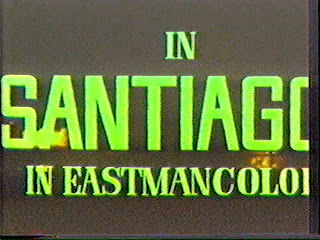 *Apparently, like other films produced under LEA Films, this one is presumably lost except for the bad video copies made of it. Yay for film preservation.
*Apparently, like other films produced under LEA Films, this one is presumably lost except for the bad video copies made of it. Yay for film preservation.Lino Brocka’s
If Mario O’Hara’s Tatlong Taon Walang Diyos (1975) is worthy of being seen (among other reasons) for its willingness to reconsider the Japanese enemy during WWII (the hatred of whom is something that should never be underestimated, especially in
However, his idleness and willingness to work but not fight was understood by the villagers as cowardice, especially by the families who have fathers and sons who are fighting the Japanese. Worse still is that he is compared to Dante Romero’s character, who, despite killing a family of Japanese informants and is seen as a hero, is revealed to a be a cold-blooded killer who kills not just out of duty, but out of pleasure. Things come to a head when Romero’s character, jealous of the attention his former girlfriend (Boots Anson-Roa) is Giving Gonzalo, reveals to the villagers that Gonzalo did indeed blew up the building that killed many civilians in the nearby town and not the Japanese. Angered, they storm Gonzalo and drive him out of the village. He returns later when the Japanese invades the town to save the villagers from the Japanese.
As an outsider, Gonzalo’s character is the person through which Brocka measures the town’s morals and values. Far from the fight themselves, the town is free to discuss issues of violence, war, and guilt while Gonzalo, having gone through the follies of war, internalizes these same issues. Through horrific flashbacks and what looks like dream sequences, Brocka allows us inside Gonzalo’s head and experience the war as it is to this one man. But from the way he cuts the scenes in the village, one can tell that in this place, it is all about the reaction to war rather than war itself. Although reaction-based editing (where a depiction of an action precedes a cut that leads to a reaction to the action; forgive me for not knowing the technical term for them) is standard in studio-made productions, here Brocka uses them to show that in this case, it’s all about the reaction, not the action the produces them. Also, it doesn’t help that when the townies speak, they speak with a very literary tone (again, standard fare in pre-70s Filipino cinema). That is, they speak with the tone of someone who hasn’t experienced the horror of the thing they speak of.
Gonzalo however isn’t exactly the perfect hero who later forgets the town’s hatred when it is his turn to save it. The film’s last scene harks back to the first scene, but this time Gonzalo knows full well what he is doing. In the last scene, Gonzalo is faced with the same dilemma: they finally crossed the bridge connecting the town across river, and they must now blow-up the bridge to prevent the Japanese from following them. But problem is that some of the other villagers are still crossing the bridge, so Gonzalo must now choose between the people already across the bridge and the other villagers still across the river. Ultimately, he chooses to sacrifice the people still crossing the bridge, giving the signal to blow-up the bridge with a large degree of certainty. Was Gonzalo sacrificing them in retaliation? Was he finally free of guilt? Or did he do it out of necessity, understanding that his mission’s importance ultimately outweighs the lives of a few? We don’t really know Gonzalo’s motivations for his actions, but if there is anything that we are sure it is that this act solidifies Gonzalo’s loss of innocence and sense of right and wrong. From the non in, a life is just yet another thing that will be eliminated if it comes down to it.
Jay Ilagan’s character underlines this loss of innocence by representing that childhood that is ravaged in the process of knowing the cruelties of life. Ilagan is introduced as a young boatman who helps Gonzalo cross the river to the nearby village, and he is also the local who showed the rebels the tunnels under the church which helped them enter the church without being spotted by the Japanese. From the character that led Gonzalo to the peaceful paradise of the town, Ilagan became the person who led him back to the harsh truths of war and death. Throughout the film, he becomes witness to the changes that Gonzalo goes through, and he himself goes through changes that reflect the demands of the small town of a man. He isn’t an innocent bystander, but the film’s Junior (Brocka’s other young witness in his epic Tinimbang Ka Ngunit Kuling (“Weighed But Found Wanting,” 1974). As an insider, he grows up defined by the ways and traditions of the town. But unlike Junior, Ilagan’s character doesn’t grow to transcend and ultimately judge the town, but rather grow to reflect the town itself.
If there is anything that the film exceeds in exceptionally well, it is the significant flashbacks that were shot and edited as if inspired by the Russian silent avante gardes. These flashbacks pierce through the relative serenity of the village by revealing the horror that the village seems to be hiding from itself. When Anson-Roa’s character embraces Dante’s character in reconciliation, he is reminded of the past: the sweet and mellow past of parades, beauty pageants, and fireworks, but also the violent past of Dante killing a family. The most significant however is Caridad Sanchez’s character’s flashbacks. Sanchez’s character is the town’s madwoman, and her flashback reveals why: raped by a gang of Japanese soldiers, her husband’s groin pierced by a bayonet, her husband leaves her to join the resistance. Later she bears the child of one of the Japanese soldiers that raped her. In a fit of rage, her husband kills the child. Mind you, these images are sensually shot in sepia as if Dovzhenko himself rose from the dead to shoot them, and cut together as if Eisenstein directed Brocka what to do. Close ups of hands, groins, and knives are interspersed along with shots of pained faces and faces in pleasure, thus abstracting the action into the objects and people’s reaction to their use. These images are coupled with Caridad Sanchez and Mario O’Hara’s great performances as husband and wife. And there are not enough words to describe how courageous their portrayals are: O’Hara having his groin pierced and bloodied in close-up, Sanchez in a very brief but very powerful topless shot.




